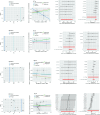Exploring the causal effects of physical activity, diet, and nutrition on hypertension and hyperlipidemia: a multivariable Mendelian randomization analysis
- PMID: 40102720
- PMCID: PMC11921495
- DOI: 10.1186/s12872-025-04539-5
Exploring the causal effects of physical activity, diet, and nutrition on hypertension and hyperlipidemia: a multivariable Mendelian randomization analysis
Abstract
Background and aim: Hypertension and hyperlipidaemia are major risk factors for cardiovascular diseases, contributing to significant morbidity and mortality worldwide. Lifestyle interventions, including modifications in diet, nutrition, and physical activity, are commonly recommended, but their causal effects on these conditions remain uncertain. This study aims to explore the causal effects of these factors on hypertension and hyperlipidaemia using multivariate Mendelian randomisation analysis, providing insights for effective cardiovascular prevention strategies.
Methods and results: Genetic data related to physical activity, diet, and nutrition were obtained from public databases and analyzed using multivariate Mendelian randomisation. The analysis employed MR Egger, weighted median, and inverse variance weighting (IVW) methods, with tests for heterogeneity and multiplicity ensuring the reliability of the results. In the hypertension analysis, low-calorie diets showed a positive association in weighted median and IVW analyses, with weighted median analysis showing an association of 1.122 (95% CI: 1.014-1.243, P = 0.026) and IVW analysis showing an association of 1.095 (95% CI: 1.013-1.184, P = 0.023). However, MR Egger's analysis showed no significant association (association of 0.688, 95% CI: 0.411-1.155, P = 0.230). Calcium supplements and dietary fibre did not demonstrate significant associations across all methods. Physical activity also did not show significant causal links with hypertension. Regarding hyperlipidaemia, calcium supplements exhibited significant effects across all methods, though with notable variation, while dietary fibre and physical activity showed no significant impacts.
Conclusions: The study suggests a positive association between low-calorie diets and hypertension, as indicated by significant results from weighted median and IVW analyses. Other dietary factors, physical activity, and calcium supplementation exhibited varied or non-significant effects on hypertension and hyperlipidaemia. These findings highlight the need for further research to understand the underlying mechanisms and support the development of effective public health interventions.
Keywords: Diet; Hyperlipidaemia; Hypertension; Multivariate Mendelian randomisation analysis; Nutrition; Physical activity.
© 2025. The Author(s).
Conflict of interest statement
Declarations. Ethics approval and consent to participate: This study did not involve direct experimentation on human participants. The data used in this study were sourced from public databases such as the UK Biobank and the FinnGen consortium, which obtained informed consent and ethical approvals from participants during data collection. Hence, further ethical approval for this study is not applicable. Consent for publication: All participants provided consent for their data to be used in this publication. Competing interests: The authors declare no competing interests.
Figures
Similar articles
-
Exploring the Causal Effects of Physical Activity, Sedentary Behaviour, and Diet on Atrial Fibrillation and Heart Failure: A Multivariable Mendelian Randomisation Analysis.Nutrients. 2024 Nov 26;16(23):4055. doi: 10.3390/nu16234055. Nutrients. 2024. PMID: 39683449 Free PMC article.
-
[Genetic Causation Analysis of Hyperandrogenemia Testing Indicators and Preeclampsia].Sichuan Da Xue Xue Bao Yi Xue Ban. 2024 May 20;55(3):566-573. doi: 10.12182/20240560106. Sichuan Da Xue Xue Bao Yi Xue Ban. 2024. PMID: 38948277 Free PMC article. Chinese.
-
Association of Physical Activity with Asthma and Chronic Obstructive Pulmonary Disease and Mediation of Frailty: Mendelian Randomization Analyses.Int J Chron Obstruct Pulmon Dis. 2024 Oct 16;19:2309-2320. doi: 10.2147/COPD.S475714. eCollection 2024. Int J Chron Obstruct Pulmon Dis. 2024. PMID: 39429808 Free PMC article.
-
Serum uric acid levels as a causal factor in hypertension: Insights from Mendelian randomization analysis.Clin Exp Hypertens. 2025 Dec;47(1):2496514. doi: 10.1080/10641963.2025.2496514. Epub 2025 May 5. Clin Exp Hypertens. 2025. PMID: 40325623 Review.
-
The role of mitochondrial DNA copy number in cardiometabolic disease: a bidirectional two-sample mendelian randomization study.Cardiovasc Diabetol. 2024 Jan 28;23(1):45. doi: 10.1186/s12933-023-02074-1. Cardiovasc Diabetol. 2024. PMID: 38282013 Free PMC article. Review.
References
-
- Omar Baoum S, Anbarserri F, Alhassan S, et al. Evaluating the impact of lifestyle modifications on hypertensive heart disease Int J Community Med Public Health. 2024;12(1):565–9. 10.18203/2394-6040.ijcmph20244074.
MeSH terms
LinkOut - more resources
Full Text Sources
Medical



